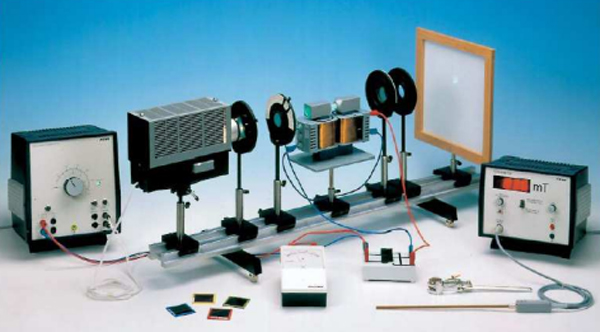Faraday effect

The angle of rotation of the polarisation- plane of plane polarised light through a flint glass rod is found to be a linear function of the product of the mean flux-densitiy and the length of the optical medium. The factor of proportionally, called Verdet’s constant, is investigated as a function of the wavelength and the optical medium.
- experience that magnetic fields can influence light by changing ist polarization properties
- learn how wavelength and the optical medium influence the effect of the magnetic field
- discover a bridge between the fields of optics and electromagnetism
Lens holder
Lens, mounted, f +150 mm
Object holder, 5×5 cm
Table top on rod
Screen, translucent, 250×250 mm
Housing for experiment lamp
Holder G 6.35 for 50/100W halogen lamp
Halogen lamp, 12 V/50 W
Double condenser, f = 6 cm
Optical bench expert, l = 1000 mm
Base for optical bench expert, adjustable
Slide mount for optical bench expert, h = 30 mm
Slide mount for optical bench expert, h = 80 mm
Colour filter, purple, 360…460 nm, 16% @ 440 nm
Colour filter, blue-green, 400…560 nm, 63% @ 505 nm
Colour filter, light green, 480…570 nm, 45% @ 525 nm
Colour filter, light yellow, 560…630 nm, 19% @ 580 nm
Colour filter, light red, >600 nm, 93% @ 595 nm
Polarizing filter with vernier
PHYWE variable transformator DC: 0…20 V, 12 A / AC: 0…25 V, 12 A
Hall probe, axial
PHYWE Teslameter, digital
Universal clamp
Commutator switch
Pole pieces drilled, 1 pair
Glass rod for Faraday effect,
Iron core, U-shaped, laminated electric steel
Coil, 600 turns
Ammeter 1mA…3 A
Connecting cord, 32 A, 750 mm, red
Connecting cord, 32 A, 750 mm, blue
- To determine the magnetic flux-densitiy between the pole pieces using the axial Hall probe of the teslameter for different coil currents. The mean flux-density is calculated by numerical integration and the ratio maximum flux-density over mean flux-density established.
- To measure the maximum flux- density as a function of the coil current and to establish the relationship between mean flux-density and coil current anticipating that the ratio found under 1. remains constant.
- To determine the angle of rotation as a function of the mean fluxdensity using different colour filters. To calculate the corresponding Verdet’s constant in each case.
- To evaluate Verdet’s constant as a function of the wavelength.
- Electromagnetic field interaction
- Electron oscillation
- Electromagnetism
- Polarisation
- Verdet’s constant
- Hall effect
